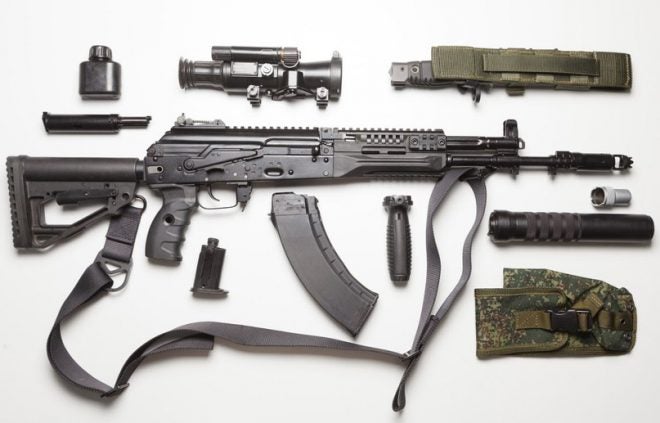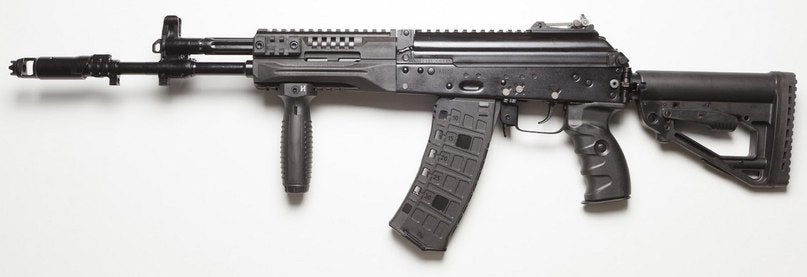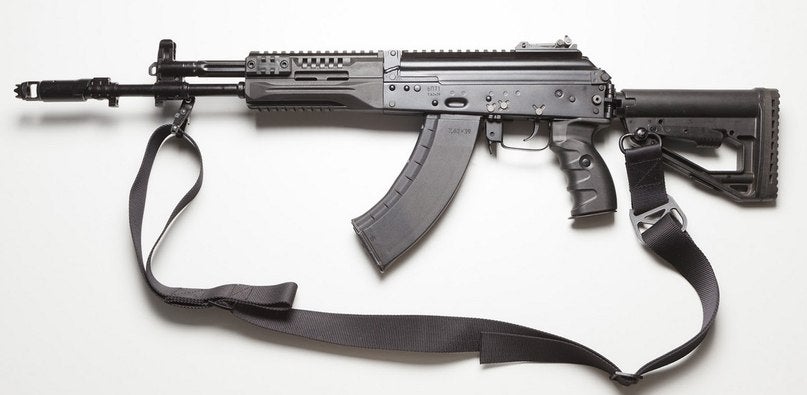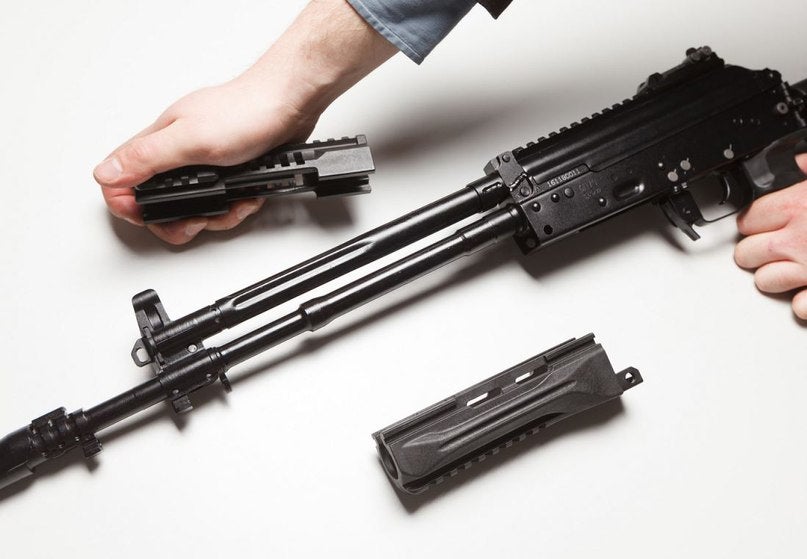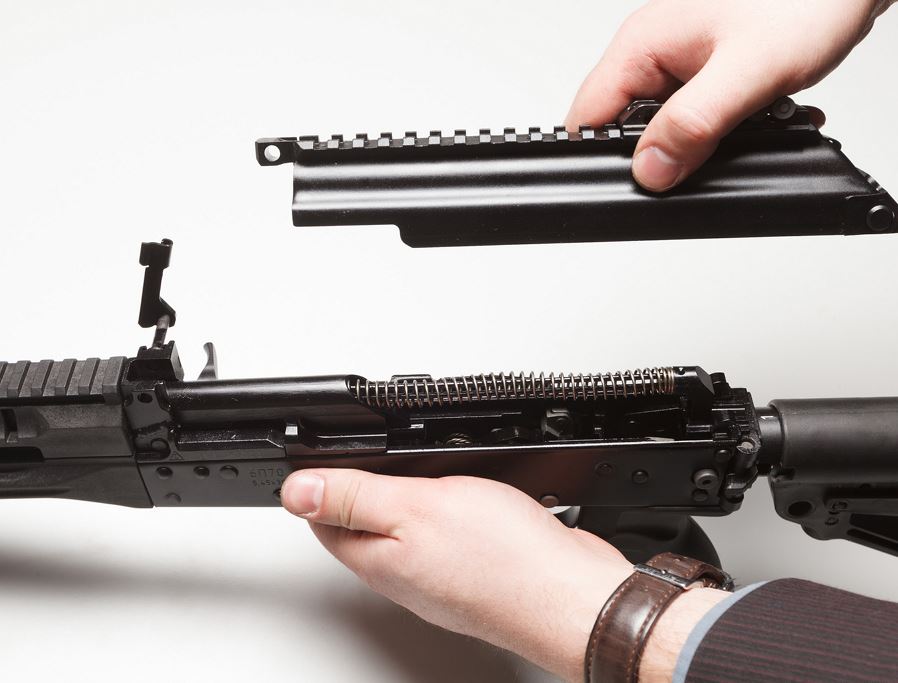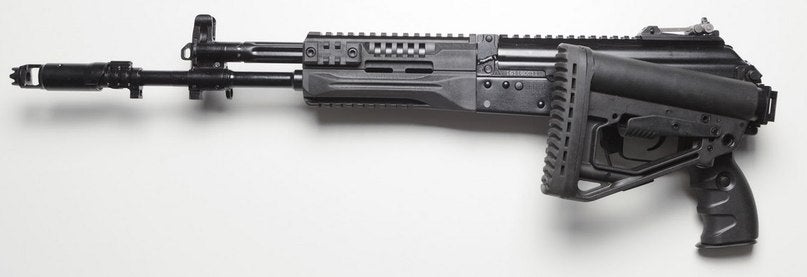With the recent official news that the new AK-12 and AK-15 rifles have been adopted by the Russian Ministry of Defense it’s with interest we with Kalashnikov’s help can take a deeper look into how the rifles were developed and engineered.
Nathaniel F reported about the adaptation here, if you missed it make sure you catch up.
Below: The Kalashnikov AK-15 (front), AK-12 (middle) and the AK-15K (back). Looks like the AK15s are using EOTechs. Does ITAR work well? The AK-15s are in 7,62 and the AK-12s are 5,45 mm. Check the magazines.
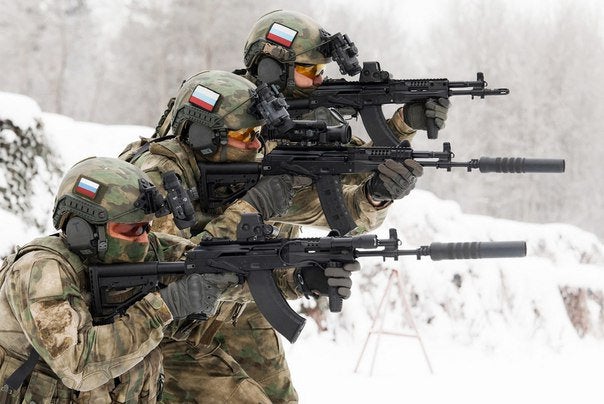
Note: The text below is auto translated from Kalashnikov’s article, with some minor edits from my side to correct the most obvious translating mistakes. A rifle is not a machine etc., but there are still some words here and there that will look funny.
The AK-12 and AK-15 automatic rifles
On January 29 of this year, information appeared that the Ministry of Defense of the Russian Federation had officially adopted Kalashnikov AK-12 and AK-15 assault rifles and recommended them for arming the infantry, airborne and marines.
What is the history of these rifles?
For almost the last 10 years, the Ministry of Defense of Russia, together with defense industry enterprises, has been working on the creation of a military equipment kit (KBEV) “Ratnik”. Among the elements of the complex, among other things, included weapons, primarily the main individual infantry automatic weapons.
Specific requirements for the new automatic rifles were not officially published, as were the numerical results of various tests (reliability, MTBF, accuracy of shooting), but the result of the competition was that it was officially successfully completed by both competing families – 6P68 and 6P69 automata from the Kovrov plant named after Degtyarev with a balanced automation and automatic machines of the “classical” design 6P70 and 6P71 from Izhevsk Concern “Kalashnikov”, better known as AK-12 and AK-15. It is about them that this story is about.
The development of the machine was started in 2011 by the IZHMASH plant (now part of the Kalashnikov concern) in an initiative order to participate in the competition “Ratnik”. Over the past time, the design of the machine has been repeatedly reviewed based on the results of the next stages of testing.
The AK-12 automatic rifle in 5.45mm and 7.62mm calibers passed state tests in 2015, receiving a number of recommendations from the commission. The main recommendations were to refine the machines for manufacturability.
During the development of 7.62mm, the version of the machine was named AK-15.
The newest variants of AK-12 and AK-15 automatic guns in the spring of 2016 were successfully tested by the state and were sent for military tests to Russian army units that were conducted in different climatic zones and combat arms, which ended in 2017. The result of these tests was the information that AK-12 and AK-15 assault rifles were officially approved by the Ministry of Defense of Russia and recommended for arming units of the Russian Armed Forces.
Below: AK-12 in 5.45×39 mm
New variants of AK-12 and AK-15 automatic rifles were first officially shown in public in September 2016, at the exhibition Army-2016. These options are quite different in appearance and design of a number of important sites from the previous version of the AK-12, shown in 2015. The design of the rifle was revised both to eliminate a number of identified shortcomings and problems, and in the direction of improving the process-ability, taking into account the wishes of the military.
Below: AK-15 in 7,62×39 mm. I guess the easiest way to distinguish an AK15 from an AK12 is the magazine.
In 2017, continuing the development of the AK-12 family, the Kalashnikov Concern showed compact variants of both variants developed under the initiative of the AK-12K and AK-15K indices. These rifles are suitable for use as a melee weapon for special forces, and as a self-defense weapon for the calculation of military equipment and heavy weapons.
Why is the rifle released in two calibers?
In fact, the main automatic cartridge of the Armed Forces of Russia and other law enforcement agencies since the mid-seventies is the 5.45mm cartridge with the metric designation 5.45×39.
At the same time, the 7.62mm cartridge of the 1943 model (7.62×39), although considered obsolete, is still in service. There are a number of reasons for this, and the main one is the lack of an effective 5.45mm cartridge with a subsonic speed of a bullet suitable for silent shooting with a silencer installed on the automatic rifle.
Similar cartridges in the 5.45mm caliber were developed during the Soviet era, but proved to be ineffective and were removed from service. At the same time, in the 7.62mm caliber, such cartridges (7.62×39 US) were successfully created and are still used in AKM / AKMS and AK103 automatic machines during special operations. Thus, a 7.62mm submachine gun complete with standard and “subsonic” cartridges and a quick-detachable silencer is a versatile weapon of special forces, unlike specialized models, which allows solving the widest range of combat missions, albeit not with such high efficiency.
As an additional illustration of the correctness of this approach, one should point out the 300 AAC cartridge (7.62×35) that is gaining popularity in the West and is an attempt to create an analogue of the Soviet / Russian weapon system for the 7.62×39 cartridge, but compatible with NATO standard weapons.
How is the AK-12 designed and engineered?
5.45mm AK-12 and its 7.62mm AK-15 version retain the traditional Kalashnikov automatic gas-tight automation with lock locking and can use stores from previous generations of 5.45mm AK-74 and 7.62mm AKMs respectively.
The gas outlet, the gas tube, the receiver and the trunk are substantially redesigned in order to increase the accuracy of the firing in all modes. The gas tube is rigidly fixed in the receiver, it is not removed during disassembly and has in the front part a detachable plug for cleaning.
The handguard and the barrel are rigidly fixed on the receiver and do not touch the barrel (a so-called “free floating barrel”), which increases the stability and accuracy of shooting. Picatinny rails helps the mounting of various aiming devices – red dot sights and laser target designators.
The cocking cocking handle is part of the bolt frame and is located on the right side of the weapon. The fuse-translator of the modes of fire is located on the usual place on the right, but has 4 positions: fuse – automatic fire – turn 2 shots – single.
Its lever has an additional “shelf” for the index finger, which provides a more convenient switching of the fire modes without changing the grip of the shooting hand.
Below: The AK-12 Kalashnikov assault rifle is equipped with a Picatinny rail on the removable cover of the receiver, which provides convenient and repeatable installation of day and night sights of various types. The receiver’s cover is removable, fixed to the receiver with a cross-check in the front and has spring-loaded elements to eliminate backlash and pitching that could appear during the long operation of the weapon. Mounting the cover ensures that the sighting of the set sights is maintained after disassembling and assembling the weapon, as well as during active use. On the fore-end, there is also a Picatinny rail for the installation of additional accessories.
Mechanical sighting devices include a gas flask mounted in the gas chamber and an adjustable diopter adjustment mounted on a detachable mount in the back of the bar on the receiver cover. The target has a range of 100 to 800 meters.
The rifle is equipped with a foldable, length-adjustable butt, butt and ergonomic handle made of impact-resistant polymer.
The barrel is equipped with an effective removable muzzle brake-compensator, in addition, it is possible to install a bayonet knife or a quick-release muffler sound shot. It is possible to install a 40mm grenade launcher GP-25 or GP-34. A pencil case with a cleaning accessory is located in the pistol grip of the weapon, a de-mountable three-section ramrod – in the butt tube, under its sliding pad
What are the prospects for this weapon?
Of course, the main prospect is the deployment of mass production of automatic weapons in the interests of the Russian army and other law enforcement agencies. Of course, these machines also have a good export potential. In addition, based on them, promising civil variants of self-loading carbines of calibers 5.45 and 7.62mm have been developed, which will certainly interest domestic shooters.
At last, two pictures of the AK-15. Ready for NV-battle vs. partly stripped and with accessories including a suppressor.
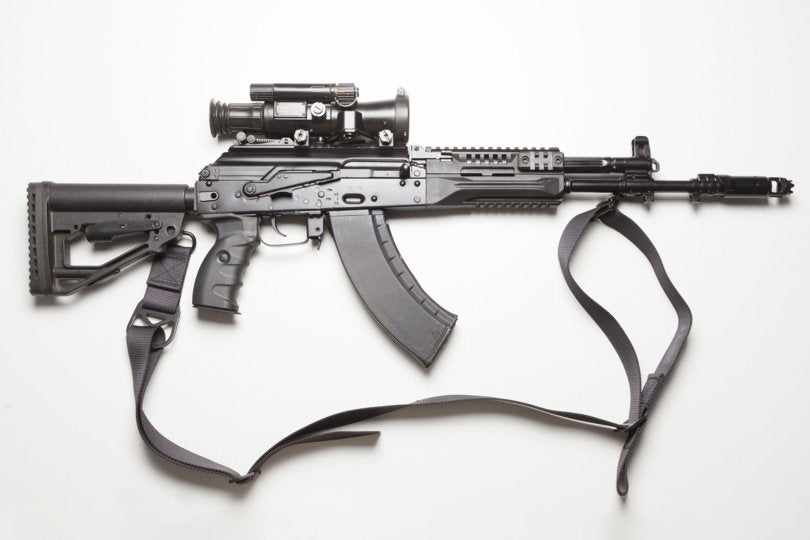
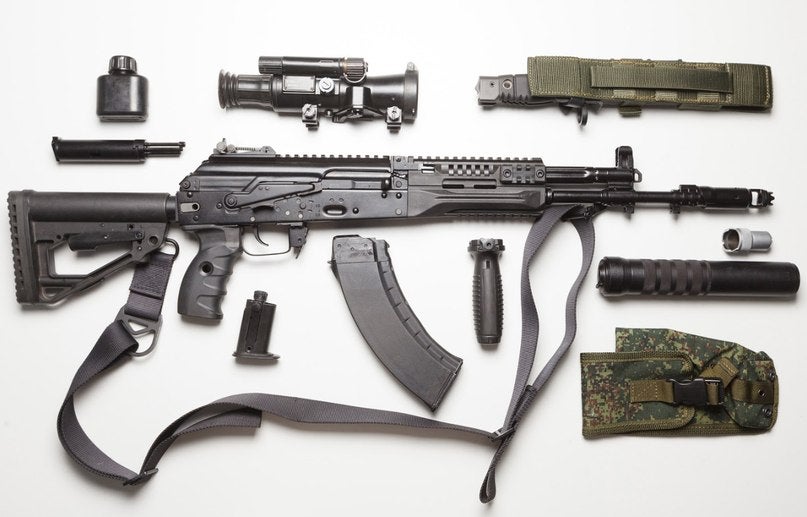
Thanks to Kalashnikov Media.
Source: https://vk.com/@concernkalashnikov-avtomaty-ak-12-i-ak-15
 Your Privacy Choices
Your Privacy Choices
